
This is a set of experimental 3D fractals generated with various software applications for the technical and creative exploration of computer generated abstract mesh creation.
All of these beautiful and sophisticated fractals belong to the quaternion, hypercomplex, cubic Mandelbrot, complexified quaternion and octonion renderings of the Mandelbrot and Julia sets. Some others are based on iterative 3×3 matrices where power series are utilized for transcendental and trig functions. The color treatment for each fractal was decided upon by it’s shape and form.
The procedure for generating and rendering 3D fractals involves a number of complex steps. First, a fractal generation application must be used to calculate the mesh object. Most of these were generated using Mystic Fractal’s QuasZ and Julia 4D. This process can take anywhere from minutes to hours, depending on the complexity of the fractal set. Once the object has been calculated, the mesh must then be exported for use in a traditional 3D rendering application. Polygon optimization methods must be applied since the generated meshes tend to be extremely dense and it is not uncommon for many of these objects to be in excess of 1-3 million polygons.
3D fractal meshes are always calculated by using a step value. This can be visualized as the 3d resolution of the mesh. Mesh step size limitations are usually visible as jagged or pixilated curves but are unfortunately often unavoidable which is why exporting geometry is never as ideal as generating and shading the object within the same software.

Once textured, lit and rendered, the images were heavily processed in Photoshop where color correction and post effects were applied as a final pass. About 75% of the work in each image was done in Photoshop using a Cintiq.
Created by Richard Rosenman.

